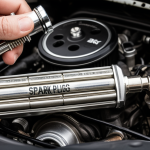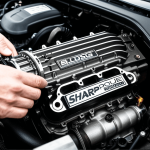Overview of High-Performance British Engines and Their Unique Needs
High-performance British engines are renowned for their sophisticated engineering and distinctive characteristics. These British engine types often emphasize a blend of power, responsiveness, and historical design elements that call for tailored maintenance and attention to detail.
Key characteristics of high-performance engines include higher compression ratios, precise fuel delivery systems, and enhanced ignition requirements compared to standard engines. For example, many classic and modern British engines demand exact tuning to achieve optimal combustion efficiency without sacrificing reliability.
A découvrir également : Maximize Your British Plug-In Hybrid’s Battery Longevity: Expert Strategies for Peak Efficiency
Popular models such as the Jaguar XK series, MG V8 engines, and Triumph’s inline-fours each present unique engine requirements. These range from specific ignition timing to particular materials and design tolerances in components like spark plugs, which must handle higher heat loads and deliver consistent sparks under increased strain.
Precision in maintenance and part replacement is critical. Using incorrect components or neglecting detailed adjustments can result in reduced power output, engine knocking, and poor fuel economy. Therefore, understanding the unique classification of British engines helps in choosing suitable parts, ensuring performance stays at the peak while preserving engine longevity.
A lire en complément : The Complete Guide to Cleaning and Caring for Alloy Wheels on Your British Car: An In-Depth Step-by-Step Manual
Role of Spark Plugs in Maximizing Performance and Efficiency
Spark plugs are pivotal to engine performance, directly impacting the combustion efficiency that defines how effectively fuel converts into power. Their primary role is to generate the spark that ignites the air-fuel mixture within the combustion chamber. This ignition initiates the controlled explosion that propels the pistons, producing the necessary power output.
When spark plugs function correctly, they facilitate complete combustion, which optimizes power delivery and fuel economy. In high-performance engines, especially British engine types known for their precise engineering, the importance of quality spark plugs becomes even more evident. A compromised spark plug can cause incomplete combustion, leading to reduced power output, increased emissions, and engine knocking.
Common signs of worn or failing spark plugs include rough idling, difficulty starting the engine, misfires, and noticeable drops in acceleration. These symptoms occur because degraded spark plugs produce inconsistent sparks, disrupting the precise timing and energy release essential for peak engine performance. The link between ignition quality and maximum efficiency is crucial; even a slight drop in spark plug condition can undermine the sophisticated tuning that British high-performance engines require.
Maintaining ideal spark plug function entails regular inspection and timely replacement, ensuring the engine’s combustion process remains uninterrupted and optimized. This proactive approach helps safeguard the delicate balance of timing and power that high-performance British engines demand for superior driving dynamics.
Selecting the Right Spark Plugs for British Performance Engines
Choosing the correct spark plug for British engine types is critical to maintaining the delicate balance of power and efficiency these engines demand. Each high-performance engine has unique engine requirements that influence the ideal spark plug specification. For instance, Jaguar XK engines often require plugs with a specific heat range to cope with their higher compression ratios, while Triumph inline-fours may need plugs optimized for rapid combustion and responsiveness.
The primary spark plug selection criteria include material type, heat range, and gap settings. Three common materials are used: iridium, platinum, and copper. Iridium plugs offer superior durability and consistent sparking under extreme conditions, ideal for sustained high rpm in British performance engines. Platinum plugs provide a balance of longevity and performance at a moderate cost, suitable for engines with moderate demands. Copper plugs, while less durable, allow better conductivity and are often favored in older British engines that prioritize raw spark intensity over lifespan.
Understanding the heat range is vital. It refers to the plug’s ability to dissipate heat from the combustion chamber. A plug that runs too cold may foul quickly, while one that’s too hot can cause pre-ignition or engine knocking. Therefore, selecting the correct heat range based on the specific British high-performance engine classification ensures consistent combustion efficiency and maximizes power output.
Adjusting the spark plug gap is another important factor. The gap size affects the spark’s strength and timing, directly influencing engine performance. British engines, known for their precise tuning, typically require exact gap measurements to maintain ignition quality and avoid misfires.
In summary, successful spark plug selection for British performance engines hinges on understanding the specific engine’s classification and requirements, choosing appropriate material types like iridium or platinum, and setting the correct heat range and gap. This tailored approach sustains peak combustion efficiency and prolongs engine life.
Overview of High-Performance British Engines and Their Unique Needs
High-performance British engines distinguish themselves through their meticulous classification and tailored engine requirements. These engines often incorporate advanced design elements that optimize power and responsiveness, requiring maintenance that respects their unique engineering.
Key characteristics include precise fuel delivery and higher compression ratios, both demanding exact calibration. For instance, British engine types such as the Jaguar XK and MG V8 exemplify specific tuning necessities. These models require parts that can withstand elevated thermal and mechanical stresses, reflecting their high-performance status.
Precision in maintenance and component replacement is vital. Incorrect parts or improper adjustments may degrade engine efficiency, cause knocking, or lead to power loss. Understanding the distinct classification of British engines aids in matching the right components, ensuring that performance and reliability remain uncompromised.
Thus, the intricate balance of design and function in British engine types elevates the importance of specialized care and adherence to manufacturer specifications for sustaining their high-performance capabilities.
Overview of High-Performance British Engines and Their Unique Needs
High-performance British engines are defined by their precise classification and demanding engine requirements. These British engine types often incorporate advanced design features such as higher compression ratios and intricate fuel delivery systems that set them apart from standard engines. For example, models like the Jaguar XK and MG V8 showcase engineering focused on maximizing power and responsiveness through tightly controlled combustion processes.
The unique engine requirements of these British engines necessitate specialized maintenance approaches. Each component, including ignition and fuel systems, must be calibrated to exact manufacturer specifications. Such precision ensures that the complex mechanical dynamics operate smoothly under high stress and temperature conditions, which is typical of high-performance engines.
Popular British models also differ in their specific needs: Triumph inline-fours require rapid ignition responses, while MG V8 engines demand components capable of enduring intense thermal loads. This variability underscores the significance of proper classification—knowing the exact engine type guides the choice of compatible parts and maintenance routines.
Precision in both diagnostics and part replacement is critical. Using incorrect or generic components can lead to engine knocking, power loss, and decreased reliability. Therefore, careful adherence to the distinct engine requirements of each British engine type supports sustained performance and protects the engine’s integrity over time.
Overview of High-Performance British Engines and Their Unique Needs
High-performance British engines are characterized by their precise classification and stringent engine requirements, which differentiate them from standard powertrains. These British engine types typically feature elevated compression ratios and sophisticated fuel delivery systems designed to enhance responsiveness and power output. For instance, models such as the Jaguar XK and MG V8 embody these features, demanding components that can sustain higher thermal and mechanical stresses inherent in high-performance engines.
Each British engine model requires specialized care due to its distinct mechanical and combustion characteristics. Triumph inline-fours, for example, prioritize rapid ignition and quick throttle response, while MG V8 units necessitate parts capable of handling intense heat and pressure. This variability underscores why a clear classification of engine type is indispensable—it guides accurate maintenance decisions and ensures that replacement parts meet the exacting engine requirements for optimal function.
Precision in maintenance and parts replacement is particularly critical for these engines. Using non-specific or incompatible components can disrupt combustion timing, cause engine knocking, and reduce overall power. Adhering strictly to manufacturer specifications and understanding the unique needs of each British engine type helps maintain peak performance and long-term durability. This approach preserves the integrity of the finely tuned balance between mechanical design and operational efficiency that defines high-performance British engines.









